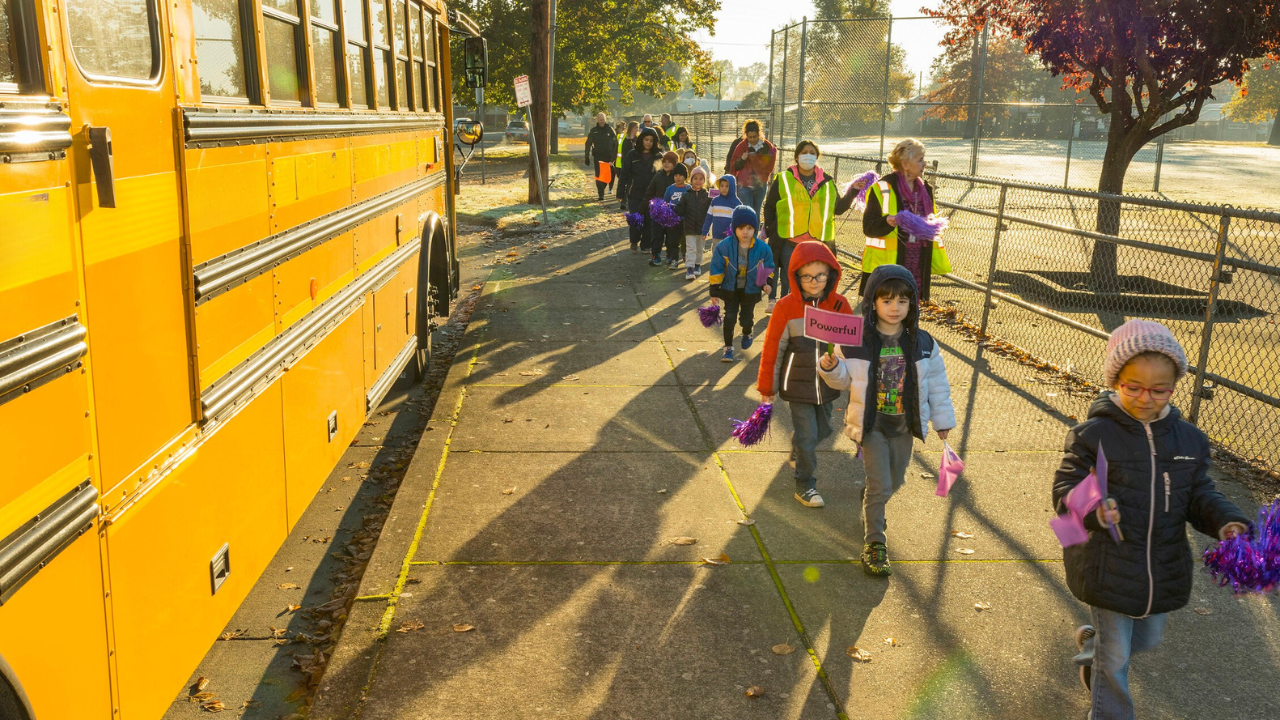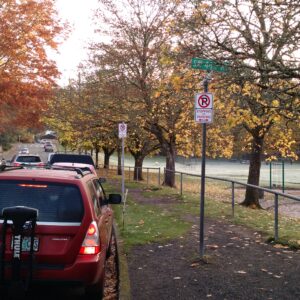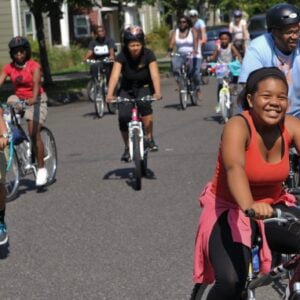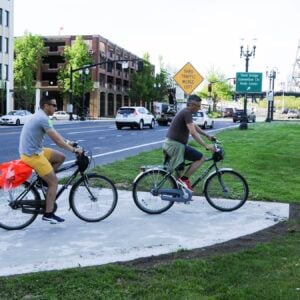
If you’re reading these words you’ve almost certainly heard of bike buses — the pedal-powered phenomenon that’s sweeping Portland and the nation. But there’s another version of the bike bus that doesn’t includes bikes. It’s known as a walking school bus. The idea is exactly the same, but instead of bikes swarming the street, kids and parents stick to sidewalks.
They don’t get as much media attention as their bicycling brethren, but walking school buses are about to take off in Portland thanks to a $964,000 grant to nonprofit Oregon Walks from the Portland Clean Energy Fund, which is run by the city’s Bureau of Planning & Sustainability. PCEF raises revenue from a 1% tax on the Portland-based retail sales of large corporations. The Oregon Walks grant will be spread over three years.
I reached out to Oregon Walks to learn more and heard back from Project Manager Sara Etter.
Etter said Oregon Walks identified a need for the students who live close enough to school (within 1-1.5 miles) so they aren’t eligible for a ride on the free yellow school bus, don’t have the option of being driven to school, and live in a place with infrastructure challenges that make walking alone risky.
Those factors, combined with the knowledge that driving emits greenhouse gas emissions, removes an opportunity for physical activity, and contributes to chaotic school drop-off and pick-up lines, made wanting to encourage more walking school buses a no-brainer. “Plus, it’s fun!” added Etter, in an email to BikePortland this week.
So, what will the money be spent on?
“Our grant will fund the widespread deployment of walking school buses across Portland,” Etter explained. “The funds will be used primarily for staffing to organize and manage the program as well as to hire walk leaders/chaperones. Some funding will also go toward the purchase of needed materials for the walks and events, and other costs such as professional development and marketing.”
The idea is that every student who lives inside the busing radius will have a scheduled, adult-supported trip to school they can count on. The vision is to have clearly identified routes, meeting sites, and pickup times. The adult chaperone will walk the route and lead the group while teaching the kids basic walking safety tips along the way. Being able to pay these chaperones is a core tenant of Oregon Walks’ program. “Staffing the chaperones with paid members of the community makes this a professionalized transportation team,” Etter said. It’s also an important equity issue, she added, “Because it signals that student safety and attendance for those students within walking distance of school matters just as much as those students who receive busing services.”
Etter is already setting up partnerships with with housing providers for pickup locations and to encourage participation in the program. The first walking school buses will be on routes in east Portland in areas that have lower quality walking infrastructure and that serve a higher percentage of Black students and other students of color as well as families that have low incomes.
For schools that aren’t lucky enough to partner with Oregon Walks, there’s another avenue to explore. When the Oregon Legislature passed House Bill 3104 in 2023, they authorized school district staff to seek reimbursement from the Oregon Department of Education for expenses related to walking school buses, bike buses, and even crossing guards (after a plan is submitted and approved by ODE). I’ve asked ODE if anyone has taken advantage of that program and will update this post when I hear back.
For Etter and her team, there’s a lot of work already happening to get the first buses up and running: safety and liability protocols, recruitment strategies, bus leader trainings, route planning and so on. She hopes to have the first walking school bus up and running sometime next year.





Thanks for reading.
BikePortland has served this community with independent community journalism since 2005. We rely on subscriptions from readers like you to survive. Your financial support is vital in keeping this valuable resource alive and well.
Please subscribe today to strengthen and expand our work.
A lot of the infill sidewalks that were put in during Adams’ mayorship as part of EPIM were near public schools, to make that final-mile just a bit easier and safer.
The elementary schools with the best sidewalk connectivity in EP are likely Cherry Park in the Hazelwood NA of the David Douglas PSD, Kelly Elementary in Lents in the PPSD, and Shaver Elementary in the Argay NA and Russell Elementary in the Russell NA, both in the Parkrose PSD.
Great news, and an excellent use of PCEF funds! I’m currently in Lisbon, where (from what I’ve seen and read) most elementary-aged children walk to and from school.
When I was growing up, most elementary aged children walked to and from school. Right here in America.
Bike buses are great. Oregon Walks and the PCEF slush fund not so much
What beef do you have with Oregon Walks? Or is it the concept of walking to school in general?
Honestly, Oregon Walks much like The Street Trust seems to be wandering off the path lately. Their recent push to close off major roads and reduce police presence sounds bold, but I can’t help wondering if it’s missing the point. Sure, they want to address big-picture safety and social issues, but calling to close down key streets? That just sounds like a recipe for traffic nightmares, and I don’t see how it makes our streets safer for pedestrians.
I used to be involved with Oregon Walks because I wanted safer crosswalks, sidewalks, and street lighting. But lately, it feels like they’re focusing more on political statements than on practical pedestrian safety solutions. If they keep taking these big swings without addressing everyday safety issues, they risk losing people like me who just want real, on-the-ground improvements.
https://bikeportland.org/wp-content/uploads/2022/02/Response-to-Emergency-Declaration-on-sweeping-camps-FINAL.pdf
CONGRATULATIONS to Oregon Walks!!
LEADERS !
model the way! inspire a shared vision! challenge the status quo! enable others to act! encourage the heart!
I love this. I think my kid is going to be a little bit too far away to walk (so we’ll join or start a bike bus instead), but I’d love to have this option if he was going to walk to school.
I like the idea of using PCEF money for this, as a trial. Maybe that will end up being one good use case for PCEF – funding trials / experimental programs (I mean, as if walking is experimental). Once proven / a lot of kids use it, it should just be funded by some more stable, dedicated source. Like whatever funds the rest of school staff.
Hell yeah Oregon Walks!
Sorry. I have the West Powellhurst grade school at the end of my street on 116th. No way you could safely have a walking bus to this school. No connecting sidewalks, or crossings to get these kids safely to school other than by bus. The traffic is horrible twice a day with a mix of busses and parent’s cars.
PBOT may be able to do a handful of schools in East Portland, but they are blowing smoke for most schools east of 82nd. A police escort on the street perhaps?
I’m confused. Is the point of this comment is that since this program isn’t feasible everywhere (by your estimation), it shouldn’t happen anywhere?
That’s called equity, right?
SO very excited for this. Also, this quote “Because it signals that student safety and attendance for those students within walking distance of school matters just as much as those students who receive busing services.” gets a standing ovation from me. School districts aren’t absolved of responsibility for the safety of children who don’t qualify for the bus.